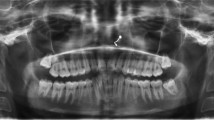Abstract
Background
A correlation between impacted maxillary third molars on the eruption potential of the maxillary second molar has been identified. There is little published evidence available in the literature regarding a treatment modality for this presentation.
Aims
The aim of this case series is to propose a joint surgical and orthodontic approach for the management of such cases.
Method
A retrospective search of all patients treated for impacted second and third maxillary molars from 2014 to 2020 revealed 24 cases. Surgical planning was facilitated with the use of a CBCT to help orientate the teeth in 3-D and assess any associated pathology to nearby structures. Twenty-three cases were treated via surgical removal of the impacted third molar and subsequently monitored for spontaneous maxillary second molar eruption.
Conclusion
All treated cases showed complete or partial spontaneous eruption followed by orthodontic repositioning if required.




Similar content being viewed by others
Data availability
On request.
Code availability
Not applicable.
References
Palma C, Coelho A, González Y et al (2003) Failure of eruption of first and second permanent molars. J Clin Pediatr Dent 27:239–246
Magnusson C, Kjellberg H (2008) Impaction and retention of second molars: diagnosis, treatment and outcome. Angle Orthod 79:422–427
Salentijn EG, Ras F, Mensink G et al (2008) The unerupted maxillary second molar, due to an overlying and malformed upper third molar: treatment and follow-up. J Orthod 35:20–24
Farronato G, Giannini L, Galbiati G et al (2011) Spontaneous eruption of impacted second molars. Prog Orthod 13:226–236
Isaacson KG, Thom AR, Atack NE et al (2015) Orthodontic radiographs — guidelines, 4th edn. British Orthodontic Society, London
Schuurs A (2012) Pathology of the hard dental tissues. Wiley-Blackwell, Chichester
Hechler SL (2008) Cone-beam CT: applications in orthodontics. Dent Clin N Am 52:809–823
Souki BQ, Cheib PL, de Brito GM et al (2015) Maxillary second molar impaction in the adjacent ectopic third molar: report of five rare cases. Contemp Clin Dent 6(3):421–424
Pogrel MA (2012) What is the effect of timing of removal on the incidence and severity of complications? J Oral Maxillofac Surg 70:37–40
Jeremias F, Fragelli CM, Mastrantonio SD et al (2016) Cone-beam computed tomography as a surgical guide to impacted anterior teeth. Dent Res J 213:85–89
Becker A, Chaushu S, Casap-Caspi N (2010) Cone-beam computed tomography and the orthosurgical management of impacted teeth. JADA 141:14–18
Roberts JA, Drage NA, Davies J et al (2009) Effective dose from cone beam CT examinations in dentistry. Br J Radiol 82:35–40
Noar JH, Pabari S (2013) Cone beam computed tomography – current understanding and evidence for its orthodontic applications? J Orthod 40:5–13
Ericson S, Kurol PJ (2000) Resorption of incisors after ectopic eruption of maxillary canines: a CT study. Angle Orthod 70:415–423
Alqerban A, Jacobs R, Souza PC et al (2009) In-vitro comparison of 2 cone-beam computed tomography systems and panoramic imaging for detecting simulated canine impaction-induced external root resorption in maxillary lateral incisors. Am J Orthod Dentofacial Orthop 136:764–765
Grammatopoulos E (2007) Gemination of fusion? Br Dent J 203:119–120
Yilmaz HG, Boke F, Ayalo A (2015) Cone – beam computed tomogprahy evaluation of the solf tissue thickness and greater palatine foramen location in the palate. J Clin Periodontol 42(5):458–461
Rabea AA (2018) Recent advances in understanding theories of eruption (evidence based review article). FDJ 4(2):189–196
Author information
Authors and Affiliations
Contributions
See supplementary form on editorial manager.
Corresponding author
Ethics declarations
Ethics approval
Not applicable.
Consent to participate
Not applicable, photographs taken with patient consent.
Consent for publication
Not applicable.
Conflict of interest
The authors declare no competing interests.
Additional information
Publisher’s note
Springer Nature remains neutral with regard to jurisdictional claims in published maps and institutional affiliations.
Rights and permissions
About this article
Cite this article
Butler, M., Rathod, N., Kerai, T. et al. The surgical-orthodontic management of combined impacted maxillary second and third molars. Oral Maxillofac Surg 26, 469–475 (2022). https://doi.org/10.1007/s10006-021-01011-4
Received:
Accepted:
Published:
Issue Date:
DOI: https://doi.org/10.1007/s10006-021-01011-4




